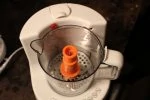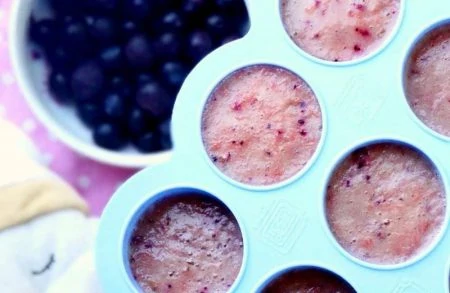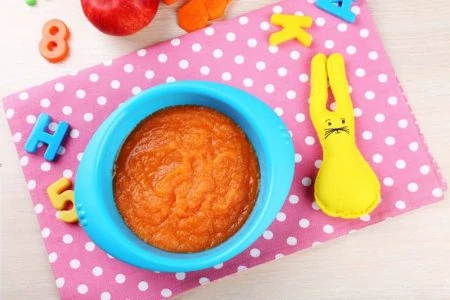Vegetables are an essential part of our diet — unfortunately for toddlers, it’s not always the tastiest. Not eating enough greens can affect our health, which is why many parents wonder how to get their toddler to eat vegetables.
Unbeknownst to many people, health authorities recommend consuming at least 5 fruits and vegetables daily (1). Achieving this is a daunting task for many families.
The best way is to lead by example and eat your own veggies, but that’s not always enough. Sometimes, you have to be more creative, such as using a fun recipe or cleverly hiding the vegetables. If you’re struggling in this area, start by following some of our tips below.
Key Takeaways
- Toddlers often dislike vegetables due to taste preferences and influences from food advertisements.
- Sneak vegetables into meals by using purees, adding them to meat dishes, or making fun recipes like “Green Eggs and Ham.”
- Make vegetables more appealing by using sweet recipes, making substitutions, or creating toddler-friendly juices and smoothies.
- Encourage vegetable consumption through fun activities, including toddlers in meal preparation, and leading by example.
Why Don’t Toddlers Like Vegetables?
First, let’s discuss why toddlers and some older children become “picky” about eating vegetables. When foods are first introduced between 4 to 6 months old, they are typically offered in a very basic form, without added sugars and salt. As table foods become part of the diet, an infant’s palate expands along with as a taste for certain flavors and seasonings. Since older infants often eat a mashed or pureed version of what their families eat, such meals influence taste preferences.
Before you think, “Oh, it’s all my fault,” it may not be. There is convincing evidence that the sugar, salt, and fat found in packaged toddler foods creates a preference for these foods instead of for vegetables. It is, therefore, important to check nutrition labels before giving them to your child.
In addition to this, food advertising is everywhere. Think about the last time you sat with your toddler to watch an educational show or video. I’m sure you both were bombarded with advertisements for a variety of “kid-friendly” foods (2). Since most of these ads are not about spinach and broccoli, vegetables look less appealing to your toddler when on a plate.
So, here are some tips to prevent your toddler from solely eating what I call “the kid trifecta”: macaroni and cheese, pizza, and chicken nuggets.
How to Get a Toddler to Eat Vegetables
1. Sneaky Vegetables
Hiding the vegetables may be sneaky, but it’s smart. Purees are fantastic for this since you can add them in without making it too obvious.
- Colors: Be careful with the colors. Use white or orange vegetables, like yellow squash or cauliflower, with mac and cheese. Once mixed, it will look like cheese, and it will give it a creamy texture.
- Meat dishes: If you’re cooking with meat, such as lasagna or meatballs, use shredded carrots, beets, or zucchini. Not only does this up the intake of vegetables, but it makes the dish tasty as well. With soups, try to juice up the greens and add accordingly. Many toddlers don’t like to see the vegetables, so pureeing them in soups may be more agreeable to them.
- Fun: You could also make it fun by recreating Dr. Seuss’ “Green Eggs and Ham.” Puree some broccoli and scramble it into the eggs.
I recommend this technique to many of my parents. Tomato sauce, for example, is a great way to hide cooked veggies. Just add them to a blender with your sauce of choice, then heat it. This sauce can be used on pasta for toddlers who are willing to eat “red” sauce, or as a pizza sauce added to prepared pizza dough. Either way, your child will get a few portions of vegetables.
Editor's Note:
Dr. Leah Alexander, MD, FAAP2. Make It Sweet
This sounds odd, but thanks to veggie fanatics, there are plenty of sweet baked goods that are full of vegetables. Have you heard of the use of zucchini in chocolate cake? It’s delicious and, better yet, so subtle that your toddler won’t notice it.
- Cookies: When baking cookies, we often use a lot of butter. However, you can substitute some of this with white-bean puree, making the dough a little healthier. Bananas are also a great substitute, and allow you to reduce the amount of sugar in your recipe. For brownies, add a package of pureed spinach.
- Cakes and pancakes: You can also try adding beets in a chocolate cake as well as carrots or squash in yellow. During the fall, experiment with pumpkin pancakes. It’s important to match the colors, though — remember, all light vegetables go with light-colored cakes.
3. Substitutions
If you can’t sneak the veggies in, simply switch the whole thing up.
- Veggie burgers: These are great substitutes instead of regular meat patties and work wonders. You can disguise them with some cheese and other vegetables your toddler is used to eating with their burgers. Just be sure to research which veggie burgers are certified, hexane-free. Hexane is used in the processing of some soy-based versions, and is a neurotoxin (3).
- Spaghetti squash: This is a godsend for picky eaters. It looks, and pretty much tastes, like real spaghetti. Cover it up with some sauce and cheese — your toddler will never notice the difference.
- Tacos: Tacos are another excellent way to substitute meat. Instead of beef, use veggie crumbles. Disguise it under sour cream or shredded cheese.
4. Juice It
A simple way to make vegetables more appealing is by creating a toddler-friendly juice or cocktail. If your little one doesn’t mind, you can easily serve it as it is. You could also make it into a smoothie by adding yogurt, nut butter, or milk. Smoothies have the added benefit of keeping the fiber of the fruit or vegetable, while making the flavor more toddler-friendly.
- Ice pops: With vegetable juice, you can create fun ice pops. Everything is more fun when in the shape of an icy treat.
- Fruit: Adding a little fruit won’t hurt — it will only give some sweetness to it. Bananas, spinach, grapes, honey, and some greek yogurt make for a nutritious blend.
There are many prepared blended juices and smoothies available on the market, something very convenient for busy parents. However, some contain added sugar, so it is important to check the nutrition label.
Also, I have some parents who use bottled fruit juice to make veggie smoothies for their children. Unfortunately, such juices contain lots of sugar, this making the smoothie unhealthy (4). I recommend using coconut water instead which also gives added potassium.
Editor's Note:
Dr. Leah Alexander, MD, FAAPBaby Under 12 Months?
5. Make It Fun
Instead of using force, try fun. Toddlers love it when you make a situation fun, and a great way to do this is by creating a game (6).
Sit down with your toddler and help each other divide the vegetables into color-coded categories. Then, you can ask them which color you should eat today. The one they choose must be one of the foods on both of your plates.
You could also ask them which color to add on a pizza or tacos. By doing this, you’re giving them a sense of achievement as they help with dinner.
6. Include Them in the Process
Our little one despised vegetables until he began helping out in the kitchen. Including him in the process was the tip that worked wonders. By letting him do his small experiments, he would end up eating them as well.
It’s best to start by creating a safe space — all sharp knives off the counter. You can easily find kid-friendly kitchen tools online. Then, choose a small selection of vegetables for them to focus on — pick items that go well together.
Let them immerse themselves in the process. Ask them to choose a method of cooking, but keep them away from the stove. While the veggies are cooking, have your toddler prepare something else.
Once finished, let your helper sprinkle on a topping, like Italian seasoning or a little cheese. You’ll be amazed to see how excited your toddler will be to dig in.
Some of my patients love a particular condiment or seasoning. Ketchup seems to be a favorite. My recommendation to parents is that, if their child will eat the vegetables when ketchup is added, then go ahead and use it.
Editor's Note:
Dr. Leah Alexander, MD, FAAP7. Teach Them About Produce
For older toddlers, you can make it educational, which will benefit them in the long run. Learning early on how to pick out ripe tomatoes or why we peel potatoes will automatically make it exciting.
This doesn’t have to be exclusively around mealtime — you can also do it while grocery shopping. Talk to your toddler about where vegetables come from — if they grow above or under the ground. Explain vegetable colors and how each benefits us, like red vegetables supporting the heart and eyes (7).
Ask which ones they like and what they don’t like. Perhaps your toddler enjoys eating the stem on broccoli but doesn’t love the top. Then explain what you prefer — but try to encourage tasting before they decide.
To bring their excitement to the next level, consider planting a small vegetable garden in your backyard. This will make them want to try new vegetables even more.
8. Try Dips
A tasty hummus dip is always included on our dinner table, and our kids have always loved it. Including dips allows your toddler to interact with the food — it makes eating so much more fun.
You can use a variety of dips, perhaps even include two options on the table. Besides hummus, you can try guacamole, fruit salsa, ranch dip, or even peanut butter for snack time.
9. Appearance Does Matter
We often eat with our eyes, so visually unappealing foods can make us hesitant to try it (8). Toddlers are no different, if not worse. Sometimes, what looks appealing to us seems gross to a youngster.
This is where fun cookie cutters can help. By transforming the veggie pattie into a dinosaur or horse, it becomes more appealing for your toddler. Create a small waterhole on the plate using ranch dip that the animals can “swim” in, and you’ve got a winner.
10. Eliminate the Competition
Our little one would always eat all the carbs on the plate, and then subtly push the vegetables aside. However, by eliminating the competition, it encouraged him to eat the veggies.
Children will always pick the most exciting food over the rest. But, by leaving out these intriguing foods, children will only have one choice — the veggies!
You can always start by serving vegetables, much like an appetizer. Offer some carrots, cherry tomatoes, and cucumbers before moving on to the main dish. This may relieve some stress since your toddler has already consumed a significant number of vegetables.
11. Lead by Example
Whether or not you as a parent consume vegetables is definitely noticed by your toddler. If he or she sees that vegetables are a normal part of family meals (and have been so since first foods were introduced), resistance to consuming them will be less likely.
Toddlers mirror the behaviors of those around them. Eating vegetables is no different (9).
12. Avoid Toddler Formulas and Supplemental Drinks
In practice, I see more and more parents who give their toddlers and older children supplemental drinks. If they have “picky” eaters who consume minimal fruits and vegetables, the parents believe such drinks can be a substitute for missing dietary nutrients.
Parents of better eaters believe they are providing additional vitamins and nutrition. Unfortunately, neither is the case. Many of such supplements are high in sugar, and actually contribute to picky eating. Sadly, I have a few patients who have stopped eating food completely, and are literally living on supplemental drinks.
Due to the increased marketing of these products, the WHO and AAP have issued statements regarding their use. Neither toddler formula nor supplemental drinks are recommended (10).
Ten Toddler-Friendly Vegetable Recipes
1. Parmesan Zucchini Tots
Parmesan zucchini tots are a great side dish or snack. They’re crispy and delicious, and they contain a large amount of zucchini.
Serve them with some ketchup or other dips your toddler loves, and they won’t notice the extra veggie punch. If you don’t have zucchini laying around, you can use cauliflower or broccoli.
2. Rainbow Fritters
Toddlers love colors and finger foods, so combining the two into one dish is bound to be a winner. Rainbow fritters are easy to make, and you can use pretty much any vegetables in your fridge. This recipe calls for peppers, zucchini, corn kernels, and carrots.
3. Broccoli Cheddar Quinoa Cups
These mini broccoli cheddar quinoa cups are fantastic finger food, and a fun way to serve broccoli. You will need some mini muffin tins to make these. But, once ready, your little one can munch on them for snack time, dinner, or even in the lunch box.
4. Hidden Veggie Power Popsicle
If you’re looking for a healthy treat, then these hidden veggie power popsicles are a good pick. They’re sweet, yet citrusy, with a smack of veggie power. It’s a great blend of vegetables and fruits, using carrots, oranges, mango, and pineapple.
5. Mac and Cheese with Hidden Veggies
Macaroni and cheese provides the perfect opportunity to include lots of healthy vegetables without overpowering the cheesy taste. This recipe calls for carrots, cauliflower, and plenty of butternut squash — veggies that are often on a toddler’s no-eat list.
6. Vegetable Chocolate Peanut Butter Muffins
An excellent way to disguise vegetables is through chocolate and peanut butter. These muffins serve as a Sunday treat for your toddler. They’re moist and sweet, and your little one won’t suspect a thing.
The chocolate muffins call for carrots and sweet potatoes. They’ll give the batter a great texture without adding to the flavor.
7. Spinach Muffins
Create some fun monster-themed muffins by combining spinach into the batter. The otherwise plain, white cakes will take on a green appearance, excellent for Halloween.
These muffins are an interesting combination of spinach, vanilla, and bananas. They’re great for small toddlers who tend to shy away from their greens.
8. Supercharged Chili
For a wholesome dinner dish that includes both veggies and meat, you can try this supercharged chili. It contains vegetables such as zucchini, eggplant, celery, pepper, and onion.
It will leave your little one’s tummy full of goodness, and it’s easy to cook as well. Chop everything up and leave it to simmer until dinner time.
9. Ultimate Hidden Vegetable Lasagna
This is a great hit for toddlers who love lasagna already. It’s a combo of carrots, mushrooms, cauliflower, red lentils, and spinach. The recipe also calls for red wine, giving you a good excuse to pop open a bottle after a long day.
It’s tasty, and perfect for hiding some of the trickier vegetables like spinach.
10. Meatballs with Sneaky Veggies
Meatballs are a statement food at kids’ birthday parties — they’re easy to make, and almost all children love them. Another great thing about meatballs is that the recipe is easy to adjust. You can add nearly any vegetable, but carrots are always a hit.
How Much Toddlers Should Eat
Although toddlers are growing, they don’t require a big plate full of meat and vegetables. They should eat small serving sizes, approximately one-quarter of your own.
Per day, aim to give your toddler 40 calories for every inch of their height (11). So, if your child is 32 inches tall, they should eat around 1,300 calories. Keep in mind this varies depending on your child’s activity level and build.
With vegetables, your toddler should consume 1 to 3 tablespoons of veggies with each meal. Plan on one tablespoon for each year of age, and then make sure to balance it with grains and protein.
Vegetables Make Us Strong
Eating a wholesome diet with a good balance of vegetables and protein is essential for a growing toddler. It provides both energy and vitamins to support their growth. But it’s not always easy getting them to eat the good stuff.
Parents often wonder how to get their toddler to eat vegetables, and luckily, it doesn’t require much effort. You can go the sneaky way by hiding veggies in favorite dishes. Or, talk to your toddler about the benefits and get them to understand why they’re important to eat.







